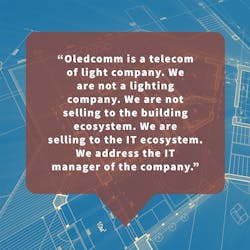Ever wonder why the French Li-Fi company Oledcomm goes by that name, when its business has nothing to do with OLEDs?
The answer: “Oledcomm” stands for “optical LED communications.” The “oled” in the moniker is unrelated to organic light-emitting diodes.
And now, “optical communications” defines the Paris company’s business more than ever, as Oledcomm has quietly exited the illumination business altogether.
In a wide-ranging interview with LEDs Magazine, co-CEOs Benjamin Azoulay and the recently appointed Pierre-Jean Beylier revealed that rather than using visible LED light from lamps and luminaires to transmit data, they are now completely focused on using infrared, informally known as “invisible light.”
In a commensurate market shift, Oledcomm is now pinning its growth strategy on selling Li-Fi into sectors such as defense, aerospace, and commercial airlines that it thinks will benefit from transmitting data via infrared methods.
Consumer communications remain grounded
In an acknowledgment that consumer Li-Fi uptake has indeed been slow, Azoulay and Beylier said that they have deprioritized the goal of outfitting consumer laptops, tablets, and phones with chips that would enable users to use light for internet communications in the same manner that radio-based Wi-Fi does today.
“We were all dreaming about having Li-Fi being integrated into smartphones and tablets, etcetera, etcetera,” Azoulay said. “I personally strongly believed in that a few years ago, because we were having concrete projects with smartphone manufacturers and with IoT manufactures. But at the end of the day, it did not materialize.”
Beylier picked up the thought. “But over the last two years, I’ve seen a tremendous change and a tremendous acceleration,” he said. “Not in consumer, but in, I would say, industrial opportunities. Where the Li-Fi technology solves problems that today cannot be solved by any other technology.”
Those opportunities include the military sector. Among other reasons, Li-Fi is generally regarded as far more secure than Wi-Fi, as it requires line of sight to intercept. (Li-Fi rivals Signify and pureLiFi have both announced deals with the US military).
“You cannot detect it, you cannot jam it,” said Beylier. “The war in Ukraine has put Li-Fi in the spotlight. It’s on everybody’s lips. Armies are looking at Li-Fi as a way to reduce the electromagnetic signature, and as a way to improve mobility in a high-intensity war.”
Traveling light
Aerospace and airlines are also ripe for Li-Fi, especially infrared Li-Fi, the two executives asserted. Three years ago, Oledcomm provided the Li-Fi systems to deliver internet connections on a trial basis to passengers for a commercial Air France flight from Paris to Toulouse. Thus far, the trial has not led to wider-scale uptake on airlines, but the time is coming, the executives maintained.
“You think of the cost of fuel, you think about the carbon neutrality objectives of the airlines — replacing cables and saving hundreds of kilos in an aircraft is extremely attractive,” said Beylier.
By why use Oledcomm’s 940-nm infrared, as opposed to visible light?
“Air France was very clear that no traveler will accept having to switch on the lights to get access to the internet,” Azoulay said.
And, he noted, there’s a broad and compelling reason to use infrared rather than visible light in general: It’s faster, because the phosphor coating used to coax blue LEDs into emitting visible white light slows down the modulation process used to encode data.
“You get much better performance with infrared than with white LED,” Azoulay said. “The speed can be three times that of white.”
Telecom of light
Like Oledcomm, Signify has also now shifted to infrared-only as a Li-Fi transmitter.
But whereas Signify might typically attach the infrared transmitter onto its visible-light LED luminaires, Oledcomm — a much smaller company and one without the lighting heritage of Signify — has walked away from illumination. It previously tried partnering with lighting companies, but “it just did not work,” Azoulay said.
Now, when the company is attempting to sell to commercial offices or the like, it does not approach the facilities department.
“Oledcomm is a telecom of light company,” Azoulay said. “We are not a lighting company. We are not selling to the building ecosystem. We are selling to the IT ecosystem. We address the IT manager of the company.” The shift began in early 2020.
The two co-CEOs are singing from the same page.
“Oledcomm is not a lighting company,” said Beylier. “We are an optical communications company. And 100% of what we do today is based on invisible light.”
Beylier provided a bullish outlook for the privately held company, based in the Paris suburb of Vélizy-Villacoublay, near Versailles.
“So in the industrial world and the defense world, there is this very clear acceleration, not only in the discussions we’re having, but also in our revenue, which is increasing very significantly in 2022 from 2021,” said Beylier, whose background includes selling communications to defense and aerospace. “It’s going to be five to six times higher. So it’s really an acceleration, but not in the consumer space, where I think it will take a number of years before we see something big.”
Getting back to the company’s name, what about the “led” in Oledcomm? Aren’t LEDs just a holding place for Li-Fi, with lasers poised to come in and deliver much faster speeds?
“Yes, I think lasers have a clear role to play, I’m absolutely convinced about that,” said Azoulay.
We’re not suggesting that the name will change to Olasercomm. But we have it on good authority that the company indeed has laser projects underway. We will bring you more on this in a separate article, along with insights on why consumer sales have been sluggish and on the standards debate that has undermined Li-Fi progress.
MARK HALPER is a contributing editor for LEDs Magazine, and an energy, technology, and business journalist ([email protected]).
For up-to-the-minute LED and SSL updates, follow us on Twitter. You’ll find curated content and commentary, as well as information on industry events, webcasts, and surveys on our LinkedIn page and our Facebook page.






